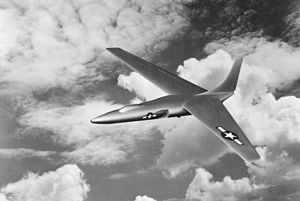Convair XB-53 Video - Convair XB-53 Swept Forward Wing Design Test
|
|
Convair XB-53

Picture - 1946 design then designated XA-44
Role: Attack aircraft
Manufacturer: Convair
First flight: n/a
Status: Cancelled in 1949
Primary user: United States Air Force
Number built: 0
The Convair XB-53 was a proposed jet powered medium bomber aircraft, designed by Convair for the United States Army Air Force. With a radical tailless, forward-swept wing design, the aircraft appeared futuristic, however the project was cancelled before either of the two prototypes were completed.
Design and development
The project was originally designated XA-44 in 1945 under the old "attack" category. An unusual forward-swept wing-design powered by three J35-GE turbojets, the project was developed in parallel with Convair's XB-46. It would have a wing with a 30° forward-sweep and 8° dihedral that borrowed from German wartime research. The swept-forward configuration would give the aircraft a greater climb rate and maneuverability. It looked promising enough at one point that the Army Air Force considered cancelling the XB-46 in favor of the XA-44 since there was not enough funding for both.
Classified as a medium bomber, the XB-53 would have carried up to 12,000 pounds of bombs as well as 40 High Velocity Aerial Rockets (HVAR) mounted on underwing pylons.
Convair argued for completion of the XB-46 prototype as a flying testbed sans armament and other equipment and substitution of two XA-44s for the other two B-46 airframes on contract. The Air Force ratified this in June 1946 but the project did not progress, nor were additional B-46s built. The XA-44 was redesignated XB-53 in 1948 when the "attack" category was dropped but the project was cancelled before the two prototypes were completed. The XA-44 program was reinstated in February 1949 but only for a short while.
Specifications (XB-53)
Data from
General characteristics
Crew: 4
Length: 79 ft 6 in (24.2 m)
Wingspan: 80 ft 7 in (24.6 m)
Height: 23 ft 8 in (7.22 m)
Wing area: 1,370 ft² ()
Empty weight: 31,760 lb ()
Loaded weight: 60,000 lb ()
Max takeoff weight: 60,000 lb (27,000 kg)
Powerplant: 3x— General Electric J35 turbojets, 4,000 lbf (18 kN) each
Performance (estimated)
Maximum speed: 580 mph (500 knots, 930 km/h)
Range: 2,000 mi (1,700 nm, 3,200 km)
Service ceiling: 44,000 ft (13,400 m)
Rate of climb: Unknown ()
Wing loading: Unknown ()
Thrust/weight: Unknown
Armament
Bombs: 12,000 lb (5,400 kg)
Bibliography
Andrade, John M. U.S. Military Aircraft Designations and Serials since 1909. Earl Shilton, Leicester: Midland Counties Publications, 1979. ISBN 0-904597-22-9.
Jones, Lloyd S. U.S. Bombers, B-1 1928 to B-1 1980s. Fallbrook, CA: Aero Publishers, 1962, second edition 1974. ISBN 0-8168-9126-5.
Knaack, Marcelle Size. Encyclopedia of U.S. Air Force Aircraft and Missile Systems, Volume II - Post-World War II Bombers 1945-1973. Washington, D.C.: Office of Air Force History, USAF, 1988. ISBN 0-912799-59-5.
Wagner, Ray. American Combat Planes - Second Edition. Garden City, New York: Doubleday and Company, 1968. ISBN 0-370-00094-3.
Living Warbirds: The best warbirds DVD series.
Source: WikiPedia